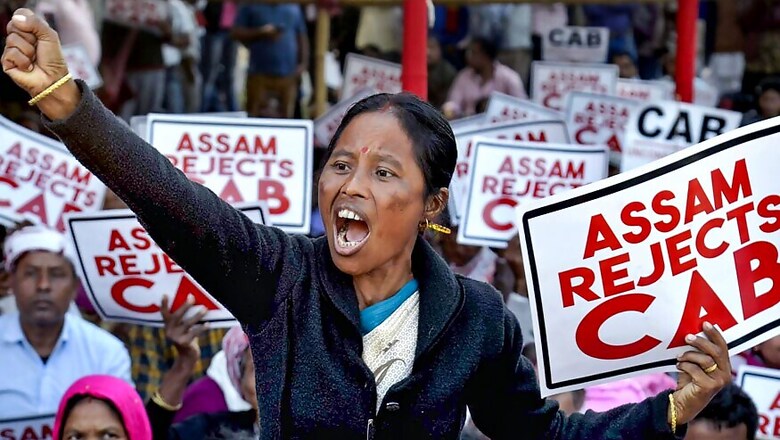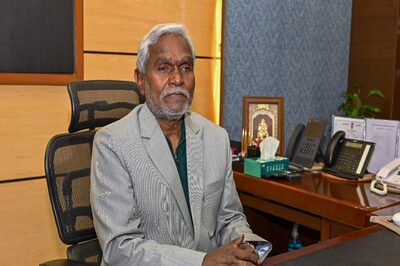
views
The passage of the Citizenship Amendment Act (CAA) in both Houses of Parliament has thrown up protests — violent and peaceful — as well as criticisms ranging from unconstitutionality of the CAA to exclusion of certain other refugees to the criminal designs of the CAA-NRC combination.
The CAA and its features have been extensively covered by this author but it is, however, useful to repeat two critical aspects in light of recent criticism.
First, it isn’t just Hindus but five other minority religions from Pakistan, Afghanistan and Bangladesh — Christians, Parsis, Buddhists, Jains and Sikhs — fleeing religious persecution who stand to benefit from the CAA.
The benefits are that one, the offence of illegally migrating in India will be pardoned and two, they can apply for Indian citizenship if they can demonstrate a physical presence in India of five years as opposed to the regular 11 years mentioned in the Citizenship Act, 1955.
Second, those among the six communities from the three countries must have entered India on or before December 31, 2014.
Given that the CAA does not render Muslim illegal immigrants any worse off, why, one wonders, is it “anti-Muslim”? One may call it ‘pro-religious persecutees’ — indeed, people from these six communities have suffered extreme torture, deprivation and threats to life.
What seemingly makes it ‘anti-Muslim’, as recent criticism suggests, is the combination of NRC with CAA.
National Register of Citizens, a concept with origins in 1951 in post-Partition India, is a register which aims at enlisting Indian citizens for the purposes of identifying who would enjoy rights as citizens (voting rights, government benefits, Indian passport) and who would not.
Consequently, this exercise shall identify migrants illegally in India to determine what India’s policy will be in regard to those so identified. It is this system of identification which, when combined with the CAA, is explained as resulting in a scenario where Muslims will be the only ones caught in the net facing the threats of detention in government centres and eventual deportation.
A significant miscalculation runs around this ‘net’ in regard to who it shall include and who it won’t. It will include all illegal migrants, no matter which religion they profess, who entered India on/after January 1, 2015. The CAA is effectively a one-time amnesty to specific religious minority persecutees from those three countries who managed to enter India before December 31, 2014.
Additionally, the ’net’ is obviously not aimed at including Indian Muslims. Having said that, let us examine the argument by critics that an inefficient NRC implementation could result in a situation where two Indian citizens — a Hindu and a Muslim — are determined as foreigners due to lack of documents. The Hindu will still get away because of the CAA, but the Muslim won’t.
This reasoning is fallacious because CAA will be rolled out first followed by a nationwide NRC. Not only is this chronology evident in the statements of Home Minister Amit Shah and others in the BJP, CAA has already been enacted as a law by both Houses of Parliament whereas NRC hasn't even been announced, let alone its criteria determined.
Do also note that all beneficiaries under CAA will be eligible in 10 days when they reach the five-year residency period on December 31, 2019. It can’t even be argued that beneficiaries under CAA will continue to become eligible for the next several years even after the NRC is rolled out making the operation of both simultaneous.
If and when the NRC is rolled out, for an Indian Hindu in the aforementioned example to subsequently claim he is a persecutee from one of those three countries will, rather obviously, be an incredulous claim. Not to forget that, in order to benefit under CAA, the Hindu in the ‘net’ will have to prove that he is a national of Pakistan, Afghanistan or Bangladesh and that he entered India on/before December 31, 2014.
Lastly, even in the remote possibility that the Hindu in the ‘net’ successfully obtains Indian citizenship through the CAA route, Section 10 of the Citizenship Act, 1955 authorises the government to revoke his citizenship on grounds of false representation when found.
The other aspect of the recent criticism is regarding the devilish nature of the NRC exercise. Additionally, certain pictorials floating around to buttress criticism, including the protest banner tweeted by Farhan Akhtar, mentioned 1971 as some type of cut-off date for validity of documents proving citizenship.
That year is actually a year of relevance for the Assam NRC, an entirely unique process guided by different circumstances and rules specifically promulgated for Assam. The misguided conflation of Assam NRC, undeniably a process fraught with issues, with a nationwide NRC has led to the creation of numerous, and baseless, rumours.
The current Assam NRC results from the Assam Accord signed in 1985 by then PM Rajiv Gandhi. One of its main, and rather explicit, purposes was to detect, delete and expel foreigners who came to Assam on or after March 25, 1971 (Clause 5.8) on an immediate basis. Hence, the 1971 cut-off date.
This led to Assam-specific changes in the Citizenship Act, 1955 (Section 6A introduced in 1985) and the Citizenship (Registration of Citizens and issue of National Identity Cards) Rules, 2003 (Section 4A introduced in 2009 by UPA government).
So grave was the issue of illegal migration felt in Assam that in 2005, Supreme Court, while striking down a 1983 law enacted to implement Clause 5.8 of the Assam Accord, lamented that the law, instead of seeing that illegal migrants are deported, did the opposite by placing the burden of proof on the government to prove that a person was an illegal migrant.
The Assam NRC procedure, quite evidently, started from the other end of the stick. Those in Assam had to submit applications to be included as citizens in the NRC. Most documents issued after 1971 were considered invalid. This burden of proof, squarely put on the applicants, ended up being foisted in a haste, given prolonged agitation in Assam and criminal delays in implementation until 2014 as the SC noted. The ‘net’, therefore, ended up including many eminent Assamese individuals and many illegal migrants were registered.
In regard to a nationwide NRC, no details have been announced. Relatively scant guidance can be gleaned from an altogether separate rule in the Citizenship Rules (Section 4) which indicates that a national NRC, as envisaged in 2003 (the year of issuance of these Rules), seems to be a house-to-house enumeration to collect specified particulars in coordination with a population register. The procedure, including the manner in which the burden of proof shall likely be carried out in practice, depicts a marked departure from that of Assam NRC.
Indeed, as and when the Modi government announces a nationwide NRC, details shall be known. The protests, therefore, are, at best, premature, based on erroneous assumptions regarding the NRC originating from the same rules which gave birth to the Assam NRC. In fact, Amit Shah himself suggested that the Assam NRC has demonstrated shortcomings which will guide the Modi government in formulating the nationwide NRC procedure.
If, therefore, the grouse with the CAA-NRC combine is that Muslim illegal migrants from the three countries — Islam being the state religion in all of them making these migrants predominantly economic migrants — are left out whereas those six communities, fleeing religious persecution, are given Indian citizenship, the basis of that grouse is, quite frankly, envy.
The CAA recognises the perils of deportation of certain sections amid extreme religious persecution. Deporting a Christian back to Pakistan exposes him to the risk of persecution based on his faith. Take the case of Asia Bibi, a Christian Pakistani. Deporting an economic migrant Muslim back to Pakistan, at worst, exposes him to a lesser payout or unemployment.
Indeed, as the government has stated repeatedly, cases of some Muslim sects who have fled to India facing persecution shall continue to be processed under the current refugee policy. But the CAA is enacted to address one specific wrong — religious persecution.
Rather than rejecting the CAA-NRC combination as ‘anti-Muslim’, the concern of informed citizens should have been that the CAA-NRC combination is ‘pro-efficiency’ ensuring safeguards, due process and inbuilt checks to avoid panic and glaring errors. Unless, of course, the argument is that illegal immigration need not ever be fixed.
If for nothing else, a nationwide NRC is needed to ensure that no illegal immigrant in the future slips into the Indian citizenship pool due to laxity of the administration or greed of political parties who, having lost faith of the Indian voter, rely on illegal immigrants getting voting rights. And CAA is needed to finally give hapless minorities, fleeing unfortunate environments in India’s neighborhood, a life of dignity which has, so far, simply been an empty promise by governments of the past.
(The author is a lawyer and columnist. Views expressed are personal)

















Comments
0 comment